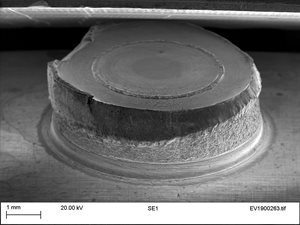A scanning electron microscope (SEM) is a type of microscope which uses a focused beam of electrons to scan a surface of a sample to create a high resolution image. SEM produces images that can show information on a material’s surface composition and topography.
How Does a Scanning Electron Microscope Work?
SEM produces magnified detailed images of an object by scanning a focused beam of electrons. This works differently to transmission electron microscopes (TEMs) as the electron beam goes straight through the object.
Electrons are created and fired using an electron gun which accelerates down the microscope passing through a series of lenses and apertures creating a focused beam which then interacts with the surface of a sample.
The sample is positioned on a stage in the chamber of the microscope before a vacuum is created in the chamber via a series of pumps. The level of the vacuum depends on the microscope’s design, while some microscopes are designed to operate in low vacuum environments, meaning that the chamber does not need to be evacuated.
Scan coils control the position of the electron beam above the objective lens. These coils allow for the beam to scan across the surface of the sample, enabling information about a defined area to be collated. The interaction between the sample and the electron create a number of signals in the form of secondary electrons, backscattered electrons, and characteristic X-rays that are then detected by detectors. The detector creates images which are displayed on a computer screen.

Example Scanning Electron Microscope Image
Why Use Electrons Rather Than Light?
The distance that the human eye can distinguish two parts in visible light is 0.2mm apart, however this can be increased through the use of a lens. This distance is called the resolving power of the lens, which can magnify the distance many times over. However, a light microscope has a resolving power of about 1000x, as it is limited by the wavelength of the light as well as the quality and number of lenses used. However, electron microscopes provide a shorter wavelength, which creates a better resolution.